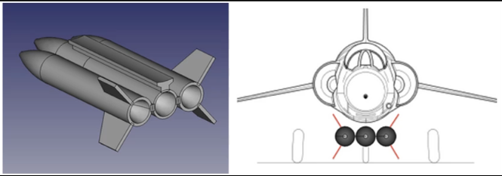See our overview video or read the summary below.
In May 2025, CubeCab completed Department of Energy grant DE-SC0025111, to investigate the regulatory and technical feasibility of a nuclear thermal launch vehicle. This design uses the extreme temperature of a small fission reactor to heat propellant beyond what chemical rockets are capable of, so as to use its propellant more efficiently. It is based on the MITEE design published in prior Department of Energy studies, with changes such as using High Assay Low Enriched Uranium (HALEU) instead of MITEE's High Enriched Uranium (HEU).
"Technical feasibility" boils down to, "will it perform its given mission with the necessary safety systems?" "Regulatory feasibility" meant discussing the existing licensing processes with the Nuclear Regulatory Commission and Federal Aviation Administration, among others. Said processes involve due consideration for potential harm to the environment and to the public.
We found that it is feasible in both senses: our design had an expected thrust-to-weight high enough to reach Low Earth Orbit even with the necessary radiation shielding, and there is a path to license this. Our technical study proposes a design that can reach Low Earth Orbit in a single stage, which is impossible for traditional rocket designs. The design is also intended for reusability, returning to the launch point after depositing their payload in orbit, with safe abort options in case something goes wrong during takeoff or reentry. For example:
- The design is for horizontal takeoff and horizontal landing. There is a mass penalty for wings and landing gear, but this allows for an accelerated stop abort. If something goes wrong upon starting up the engine, rather than launching a little ways then crashing back down to the ground, it can simply shut down the engine and stop on the runway without leaving the ground. Later versions might be traditional vertical launch, once the engine is proven and safe enough that this safety feature no longer helps as much.
- With the amount of radiation shielding contemplated in our study, the public keep-away distance to reduce radiation exposure to regulatorily acceptable levels is less than the distance needed for sonic protection. If you tried to get close to a launch in process with no protection (assuming you ran fast enough, evaded security, et al), you would get hearing damage (possibly enough to stop you by itself) before you got close enough to receive significant radiation poisoning. This is without considering any increase in sonic output this vehicle may produce, relative to other launch vehicles with comparable thrust, due to its higher exhaust velocity.
- The FAA and NRC would split jurisdiction, and licensing from both would be needed. The FAA would have jurisdiction over the launch vehicle from the start of launch operations, when the vehicle is in the hangar, until the end of launch operations, when (barring accident) the vehicle has returned to the hangar. The NRC would have jurisdiction at all other times, treating the entire facility as a non-power reactor (and possibly a research reactor, as it would not be generating revenue during the period of time when it is under NRC jurisdiction). The facility would also need FAA licensing as part of a spaceport.
Any nuclear system to be used near the public, or inside Earth's atmosphere at all, should be designed for safety. Our design uses a "closed cycle", where the exhaust will not be substantially more radioactive than a typical chemical rocket's. Sufficient shielding to limit gamma and neutron emissions to safe levels at the public keep-away distance is present; materials to do this without weighing the rocket down enough that it could not launch were much harder to find some years ago. So long as these challenges (and others common to nuclear facilities) are handled, there are environmental benefits relative to traditional rockets, as we do not need the toxic chemicals that certain other rockets use, nor do we intend to drop rocket stages mid-flight.
Launches can be prepared much faster, thanks to the inherent safety provided by the absence of traditional toxic rocket fuels. Handling liquid hydrogen still needs cryogenic safety (but can be done indoors, in a facility instrumented to detect hydrogen leaks), and the launch crew should back off to shielded areas before the engine starts up. However, as no part of the vehicle reaches hydrogen's auto-ignition temperature until after the vehicle is ready for takeoff and engine reaches initial criticality (step 2 in the list below, after the hydrogen is filled in step 1), there is a much lower potential for the rocket to explode prior to engine start (or during operation, if the engine is built and maintained correctly and if the payload is not explosive). We intend to investigate this potential safety advantage further during subsequent work.
See below sketch for an overview of the concept of operations for horizontal launch and landing. The technical report expands this to cover potential vertical cases as well.

- Outside of Launch Operations: The reactor is maintained in a shielded hangar in a zero-power configuration (aside from any ground testing) under NRC jurisdiction until final launch countdown.
- Pre-Flight Checklist: The start of this checklist marks the formal transition from NRC jurisdiction to FAA jurisdiction. Operators conduct pre-flight checks, load the payload, and fill the hydrogen tank.
- Reactor Start-Up: The launch vehicle is brought to the launch point. Operators bring the reactor to initial criticality at minimal power.
- Launch Commit: Operators increase criticality and power, begin propellant flow, build initial thrust, and release brakes. 3a is the on-runway abort option: if a malfunction is detected at this time, the operators bring the reactor subcritical, apply the brakes, and scrub the launch without the launch vehicle leaving the ground. Operators keep propellant flowing, at a reduced rate that will not produce thrust the brakes can not overcome, until the reactor cools sufficiently.
- Ascent Phase: Reactor power increases to full rated amount after the vehicle clears the launch facility, then throttles as needed to maintain optimal orbital insertion profile.
- Orbital Operations: The reactor is brought subcritical and propellant flow ceases after the vehicle achieves target velocity, then the reactor shifts to decay heat removal mode. At the appropriate time and place in orbit, the payload is ejected.
- Deorbit Initiation: Once the engine has sufficiently cooled down and fission products have sufficiently decayed (a few hours after orbital insertion), the launch vehicle turns around and starts a new, short burn phase to decelerate, just enough to begin reentry. This burn must be kept short for multiple reasons. It then turns again to achieve an optimal aerobraking profile, while shutting down the reactor for the final time during this flight. This maneuver is timed so the subsequent aerobraking will wind up with the vehicle near the desired landing area, and to enable 7a (see next step) if necessary.
- Reentry: The vehicle aerobrakes to decelerate to subsonic velocity. This phase is essentially ballistic, controlled by setting it up during the previous phase. 7a is the landing abort option: if for whatever reason the vehicle is not safe to or cannot land under active control, the ballistic trajectory of reentry carries it to a designated crash site away from any populated area. This is completely passive.
- Landing: The vehicle glides to the landing runway. After landing it returns to the hangar.
- Post-Flight Checklist: Post-flight safety checks are conducted. This phase is primarily concerned with securing the launch vehicle, and does not include after-action reports or other actions that are conducted between flights. Once flight operations formally end, jurisdiction reverts from FAA to NRC, where it remains until the next flight.
Our plan is that the first such launch vehicle will be small, to minimize development cost and risk to the public. Our report contemplates an initial prototype launch vehicle with a payload of only 24 or 180 kg. Depending on the option taken, a 12U CubeSat or an ESPA secondary would completely fill the launch vehicle. Either option is far too small to carry a human being as crew or passenger. The target market will be small, low-budget missions. Scale-up to serve larger payloads can be done after several flights have shown how to do larger versions safely (possibly through license to other launch providers who operate large launch vehicles). Our report contemplates eventually scaling up to perhaps 100,000 kg payload to Low Earth Orbit, with an expected cost once that scale-up is achieved in the low hundreds of dollars per kg, possibly under $100/kg to LEO. The initial prototype will not achieve that price target, but is expected to achieve a low total cost for the entire launch, possibly $180,000/launch for the ESPA secondary launcher or $60,000/launch for the 12U launcher. Given the customers for the prototype, "dollars to get the launch vehicle off the ground" will often be more important than "dollars per kilogram to LEO". There are many who speak only of the latter and dismiss the former, but they tend to have little concept of the realities of small satellite missions, and are not the prototype's intended customers.
As of May 2025, our study qualifies our technology as Technology Readiness Level 3: studies and analysis have been done (though there are more we would like to do) but no hardware has been constructed. Our proposed development pathway can be stated in terms of TRLs. Each of these steps includes a wide range of activities leading to the final milestone, most of which are not listed in this summary for sake of summarization. Of particular note are the licenses that will be needed for TRLs 6, 7, and 8: in each case, the prior step is intended to gather the data needed to apply for the next step's license.
- TRL 4-5: Build the engine, with electric or chemical heaters substituting for the nuclear fuel, and extensively test the hardware.
- TRL 6: As above, but use actual nuclear fuel instead of electric or chemical heaters. This may require construction of a facility at which to do these tests, which may eventually be incorporated into a spaceport.
- TRL 7: Build a launch vehicle around the engine and conduct ground tests, possibly also limited (but non-orbital) flight tests.
- TRL 8: Conduct a demonstration launch to orbit.
For more information, read our full technical report.
While CubeCab cannot share all the details in public about this project, we aim to at least provide summaries when we can. Technically minded readers may identify a number of points this summary does not answer. However, some people may prefer to spread misinformation about this project instead of acknowledging the facts, some of them with the intent of causing harm through panic. Our best defense is the truth.


